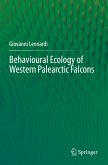Falcons have been exploited by humans as food source, ornamental purposes or for the falconry practices. There is a large historical literature in which falcons were often mentioned but always along broader topics (mainly ancient falconry and poetry). This book is the result of a parallel project developed during the preparation of "Behavioral Ecology of Western Palearctic falcons" (published by Springer in 2020). The main aim is to use archaeological and historical sources on falcons to delineate the past distribution and population ecology of these predators in the Western Palearctic ecozone. Ultimately, the approach to the data is aimed at defining the population dynamics of falcons over time. The relationship/conflict with human populations is also placed in this context. By putting falcons as a central subject of study, this book outlines their path in the Western Palearctic from the Pleistocene to modern ornithology.
Bitte wählen Sie Ihr Anliegen aus.
Rechnungen
Retourenschein anfordern
Bestellstatus
Storno








